I am not a camera tester, I'm a photographer, a photo-journalist,
to be precise. So the following is certainly not a profound test of the
new Leica M8, just a bunch of observations from a recent trip to the
southern end of the world, Tierra del Fuego (which is a collection of
remote islands belonging to Chile and to Argentina). Leica was good enough
to lend me an M8 for this trip and I'm very grateful for the experience.
Since the mid 1950ies I have used Leicas (M and M-P) as my bread-and-butter
cameras. I shot thousands of rolls of Tri-X and later Kodachrome
with them, until - in the mid 70ies - I gradually used more and more
SLRs
(first Nikons, than Canons). For a long time I carried both systems
in parallel, shooting with Leicas and wide angle lenses, and using
SLRs
mainly for the longer optics. I bought my first digital SLR in 2002
and ever since I have been fascinated by the possibilities of the digital
universe. Consequently my Leicas were gathering dust in the rear
of a
dark closet. My bread-and-butter now is earned with a Canon EOS 5D
and two zoom lenses - I try to be frugal and hate schlepping a lot
of equipment.
I love my 5D and the wide range of possibilities coming from being
digital.
But I kept in touch with Leica (formerly Leitz) and followed the announcements
of a digital "M" with
fascination and expectations. So when I unpacked the M8 it was
kind of a time-travel backwards to my younger days. The good "feel" of
handling a precision instrument came back immediately. This is
a compact but heavy metal body - hardly any plastic in there. This
thing
must be
rugged and reliable, you can feel it. I dusted off my old lenses,
they snapped right in snugly and I felt "at home". The
first thing you learn is that your thumb is superfluously now. No
rewind-lever there!
Then you press the shutter and you are surprised, if not shocked,
by the noise it makes. Not flop like the old rubber shutter but
a
kind
of click-tschrrrr. A bit loud for my taste and not so great for
unobtrusive reportage work. My Canon 5D is quieter, I think, even
though there
is a mirror going up and down.
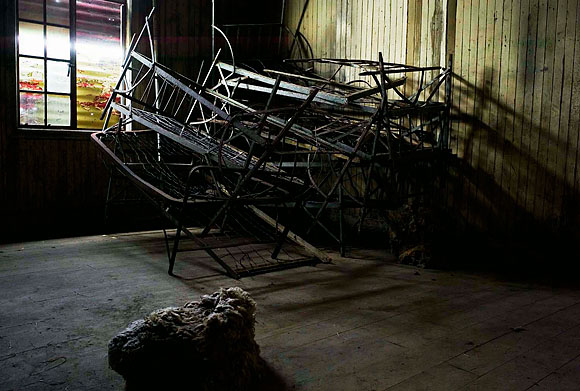
Chile, 2006,
Abandoned farm house. Iron beds stacked in a bedroom.
Next I examined the display and
the menu functions. Congratulations, Leica, this is well thought
out, rather frugal and limited to the
things one needs to know and needs to set without an overload
of bells and whistles.
There are other small amateur digital machines out there where
the manual is bigger and weighs more than the camera and you
need days
and weeks
to learn the ropes. With the M8 I din't even bother to download
the user manual for the first two weeks - everything was clear
from the
beginning.
I especially like the short menu which comes up when you press
the SET button on the back - the most important information,
brief and
clear.
Then, of course, comes the most important test - take some
snaps, download them, see them on a large monitor - and get excited!
There it is again,
the famous Leica definition, which is so hard to describe in
words. The pictures are tack-sharp but they are not harsh,
there is this
certain
modulation, a very even gradation, a pleasant feel - in short:
a Leica image. I'd bet that these digital shots are as sharp
or better
than anything
that was shot with Leicas on film, even on 25 ISO Kodachrome.
So the marriage of good old Leica lenses and the Kodak sensor
is really
working!
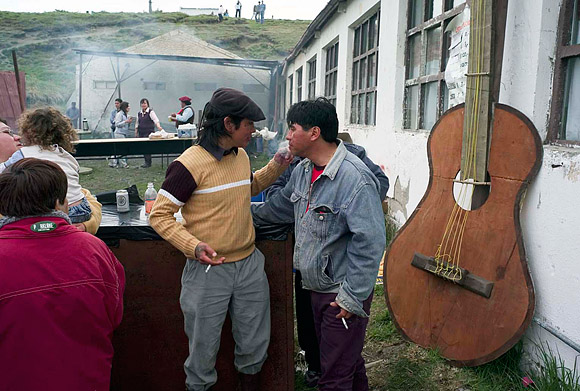
ARGENTINA, 2006, Tierra del Fuego, country fair near Rio Grande.
There is no visible noise at 160 or 320 ISO. It starts
to appear at 640 and gets pretty rough at 1250, more so than on the
5D,
I feel. When I
discussed this at a recent Magnum meeting with my friend
Costa Manos who had also tried the M8, he said that in large prints,
the noise
looks like fine film grain, not sensor noise - a good point
because, as traditional
photographers, we are not so much bothered by a grainy image
as we would be by digital artifacts.
Now the not so good
news. I had shot in parallel with the Leica and the Canon on my trip.
When I compared some pictures
of
a native Indian
whom
I had visited on a reservation in the woods of Fireland,
I was stunned to see that in one shot he had a gray windbreaker
and
blue trousers
and in another shot his jacket and pants were heavy purple.
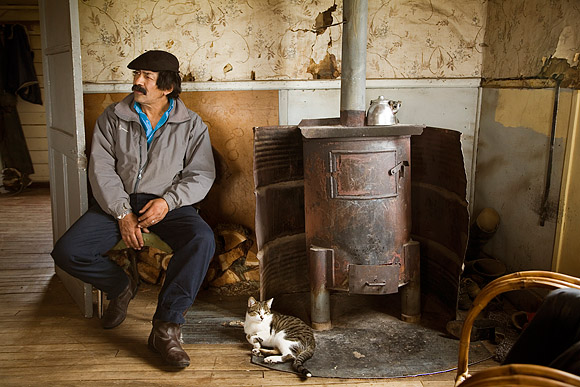
Canon 5D
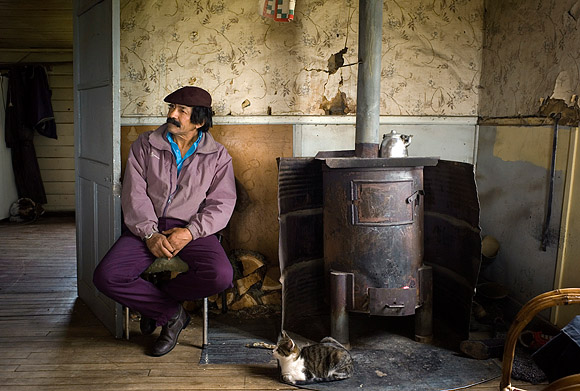
Leica M8
Needless to say,
the neutral colors came from the Canon, the purple clothing
originated from the Leica. After some internet browsing
I learned
that this
was indeed a flaw of the Leica sensor which is overly
sensitive to UV and
IR light, which is often reflected by synthetic fabrics.
One solution here would be to avoid people who wear synthetic
clothing
- the
thought, I must say, seems attractive! But, well, as
a reporter you cannot
always choose your company and the things you take pictures
of. So, Leica has
a technical and a PR problem to solve. I understand that
from now on every M8 comes with two special UV filters
which you
are supposed
to
screw onto the lenses. Sounds a bit like a band-aid to
me, not like an elegant high tech solution. But Leica seems
to be facing
a quandary
here
- fiddling with the sensor, like putting a UV filter
over it might compromise sharpness and the space is very tight
in this
body anyway.
So, what the
heck, we have lived and shot with protective UV filters
on our lenses for a long time already. So if this simple fix
works, I'd be satisfied.
Then I came across one other strange
phenomenon. When viewing my images I saw occasionally that
one shot was correctly
color-balanced while
the next frame of the same subject was totally blue. I
suspected this might
have to do with auto color balance and switched the camera
to "daylight" or "tungsten" depending
on the situation. This seemed to help. And indeed I learned
later from the web that there is a problem with auto-color
in the M8. Since I shoot
RAW the blue was easily corrected at the "development" stage,
just by setting the slider from 3300 to 6000K or thereabouts.
But it's still a bit annoying to see such a glitch in a
$5000 camera. I have
never bothered to use any other setting than Auto White
Balance on my Canon.
I hope this other Leica flaw will go away with the next
firmware update. I did not notice any banding or ghost
images, as described on the Leica
website.
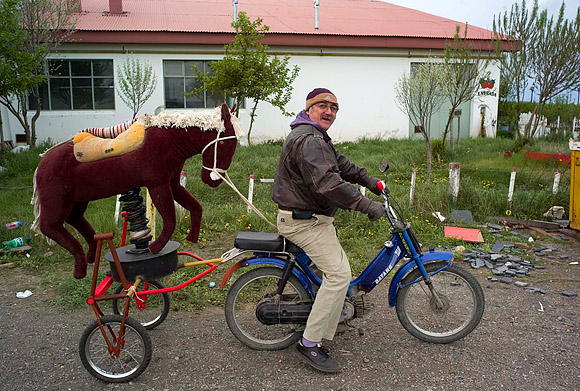
Tierra del Fuego, A man who rents a toy horse to
children leaves a country fair.
Other irritations have nothing to do with digital,
but with the fact that the Leica is a rangefinder camera.
I
confess
that I
am simply
spoiled by the precise full frame view of a good SLR and
by Autofocus. Coming
back to the Leica finder after some years seems like a
step back in time, this can be pleasantly nostalgic, but
also
frustrating. Why are there
so many bright lines in the M's finder? It's just confusing
and
you have to remember which lens you have on and to which
lines it corresponds.
It also bothers me that the lower right corner of the finder
(when shooting
horizontals) is blocked by the(wide-angle) lens and lens
shade. Something may be going on in this area in front
of me and I
have no control
over it. The art of focusing was still in my fingers and
poses no problems,
but still - the Leica is just a tad slower than my Canon
where I just press a button and the image is in precise
focus. Also
changing fixed
lenses rather than simply adjusting a zoom ring, takes
time and occasionally
one looses a shot in the process.
10 Megapixels are at the
lower end of what I would call professional resolution. 3935 pixels
on the long image
side seem a bit
low when you consider making really large prints which
may require
7000
or even 10000
pixels. But it is stunning how much interpolation these
Leica files can take. I have yet to try a 44x60" output
but the first 24x36 inch Leica print from my HP Designjet
looks just great!
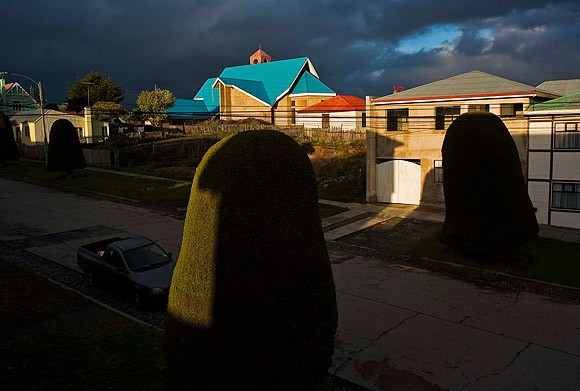
Chile, 2006, Tierra del Fuego, Porvenir, street with manicured trees
at dusk.
So will there be a happy end to my short
relationship with the M8? I certainly think so. Next
year I will take
a long
hard look
at my
bank
account ....
More images by Thomas Hoepker can be found on this
Magnum page. |